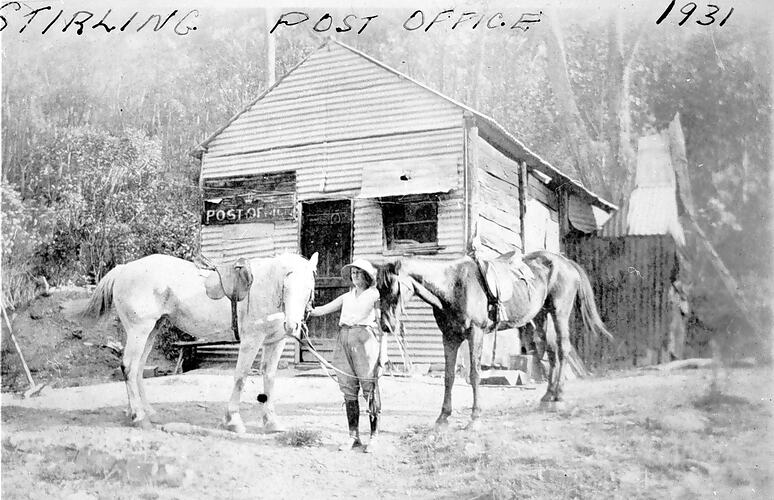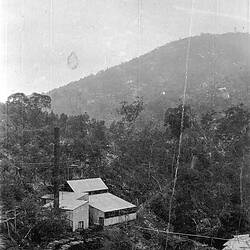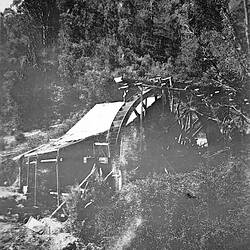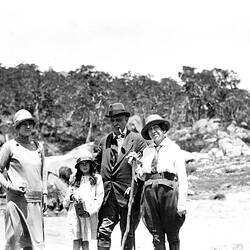Summary
Stirling was a small mining settlement on the Haunted Stream goldfield situated in rugged mountain country between Bairnsdale and Omeo. Alluvial gold had first been discovered in the area in 1863, causing a small rush that soon petered out. The discovery of several rich quartz reefs between 1882 and 1884 led to a revival, with the expanding settlement formed near the junction of Tierneys Creek and the Haunted Stream being named Stirling in 1889, in honour of the government geologist and surveyor, James Stirling (1852-1909), who had done much to assist the development of mining prospects throughout the district. Stirling had arrived in the Omeo district in 1877, working initially as a surveyor and foreman with the Crown Lands Department, before transferring to the Mines Department as an Assistant Geological Surveyor in April 1887. The town soon boasted two hotels, a wine saloon, boarding houses, a general store, butcher, baker, billiard room, post office, police station, recreation ground and Mechanics Institute Hall - which doubled as a schoolroom and church. The Haunted Steam State School (No.2845) opened in October 1887 and had an average attendance of 15 pupils throughout its first two decades.
The formation of the Stirling Proprietary Gold Mining Co. (No Liability) in 1898, marked the beginning of an era of renewed interest in quartz mining on the Haunted Stream goldfield, with new capital flowing from investors in Melbourne, Ballarat and Bendigo, and the establishment of over a dozen new mines. As mining activity extended up the winding valley, another settlement was established in 1902 near Sheepstation Creek, about 10 miles (16 kms) upstream of Stirling. It was named Dawson City after its far more populous namesake, which in the late 1890s had become world-famous as the epicentre of the Klondike goldfield in Canada's Yukon Territory, being the destination of the last great international goldrush of the 19th century.
A further decade of renewed mining activity followed before the Haunted Stream goldfield fell into an 'unusual depression' around 1912, from which it would never recover. By 1916, only three small co-operative mining parties were still active on the field making 'a fair subsistence' from prospecting and picking over former workings, taking advantage of water-power milling machinery that could be operated at minimum expense. The post office at Stirling was closed in about 1917 and by December 1918 it was reported that the townships of both Stirling and Dawson City had 'practically passed into oblivion', with only three families still residing in the valley. After a limited revival in prospecting during the 1930s depression, the Haunted Stream Mining Division was abolished in May 1936, with the area it had encompassed being absorbed into the adjoining Mitchell River Mining Division of the Gippsland Mining District.
Description of Content
A woman wearing riding boots, jodhpurs (breeches) and a wide-brimmed hat, holding two horses by the reins, standing in front of the Old Stirling Post Office, in a bushland setting. The former post office is a simple single-gabled building constructed of timber and corrugated iron, with a split 'drop log' exterior wall and corrugated iron chimney on the right-hand side. There is a single wooden door in the centre of the facade, with a small serving window with overhead rainhood to the right of the door and a wooden signboard to the left of the door with a peeling fading label that reads: 'POST [crown symbol] OFFICE '.
More Information
-
Collection Names
-
Collecting Areas
Information & Communication, Sustainable Futures, Images & Image Making
-
Acquisition Information
Copied from E. J. Conn, 09 Nov 1987
-
Place & Date Depicted
Post Office, Stirling, Haunted Stream, East Gippsland, Victoria, Australia, 1931
-
Format
Negative, 35 mm, Black & White
-
Inscriptions
Handwritten across top of original negative/photograph: 'STIRLING POST OFFICE 1931' Handwritten across bottom of original negative/photograph: 'CLOSED ABOUT 1917'
-
Classification
-
Category
-
Discipline
-
Type of item
-
References
In a letter to the Weekly Times, published in August 1915, former resident Edwin J. Conn recalled earlier life in the township of Stirling:
"SOMETHING ABOUT STIRLING. Edwin James Conn, who lives at Tambo Crossing, writes:- Dear Uncle Ben.- The place we lived in was Stirling. There used to be a lot of mines there, but here are only two working now. The ones that are working are doing very well. The last crushing was 84 ounces from 50 ton of stone. The other claim went 27 ounces from 20 ton of stone. There were nine batteries there a long time ago. One time there were hundreds of people. There were two hotels, three stores, and several boarding houses, a butcher's shop, a library, and a State school; now there are very few people living there, and no business places at nil. Supplies come from Ensay, a distance of over 23 miles. I am eight years and 10 months old. Please may I write again? (Yes. Edwin, you may write again -Uncle Ben)."
'Something About Sitrling', Weekly Times (Melbourne), Sat 21 Aug 1915, p.37, [Link 1]
-
Keywords
Chimneys, Corrugated Iron, Horse Riding, Horses, Noticeboards, Riding Clothing, Post Offices, Timber Buildings, Windows




